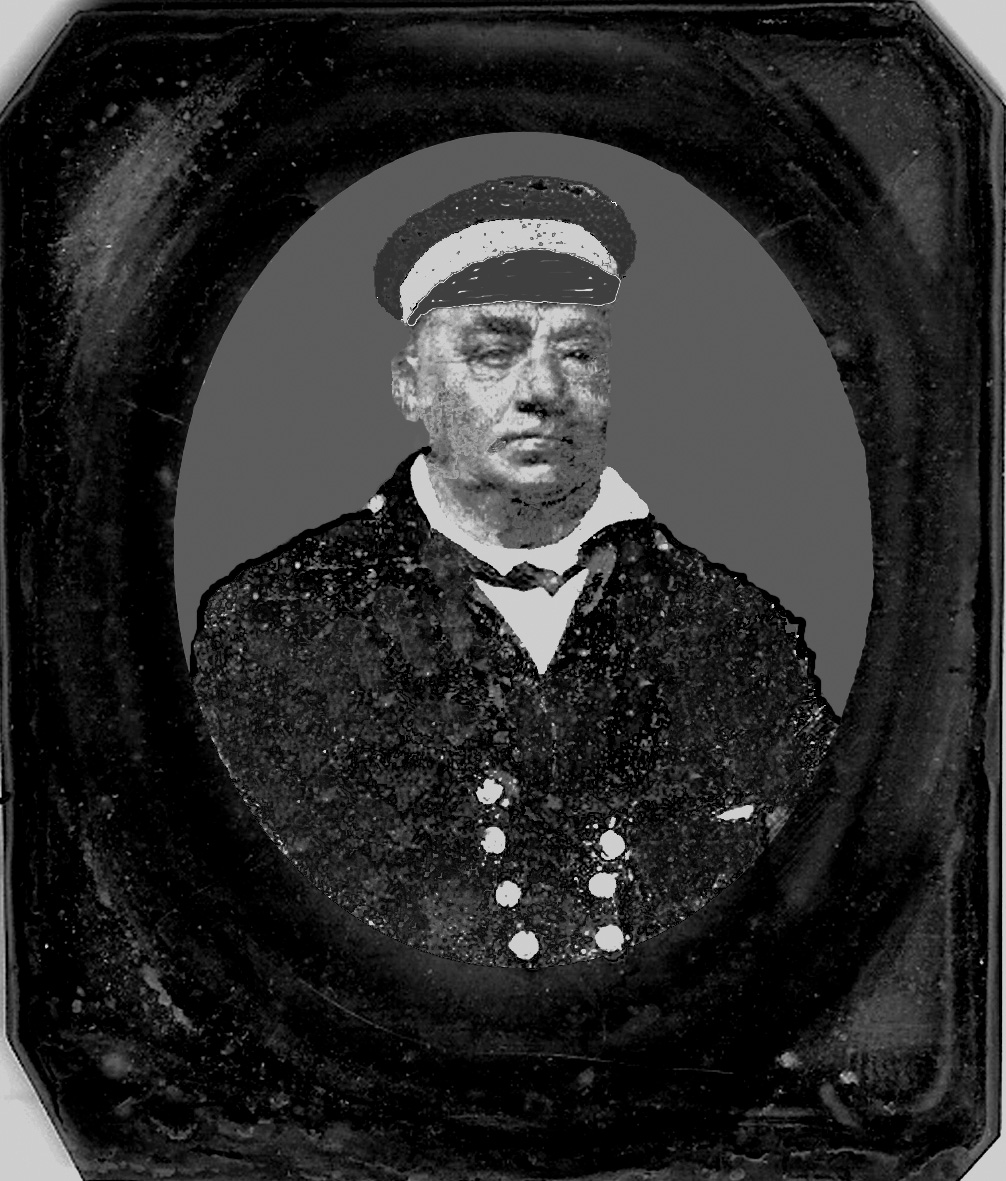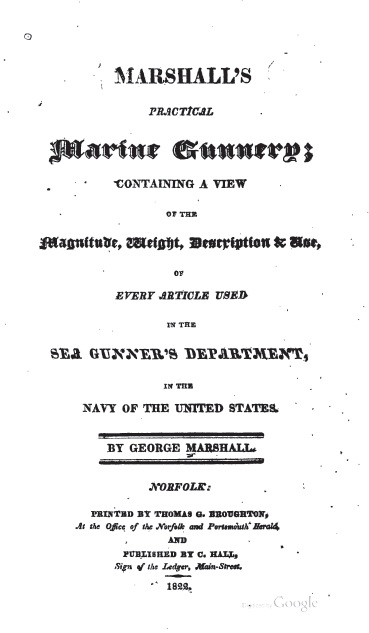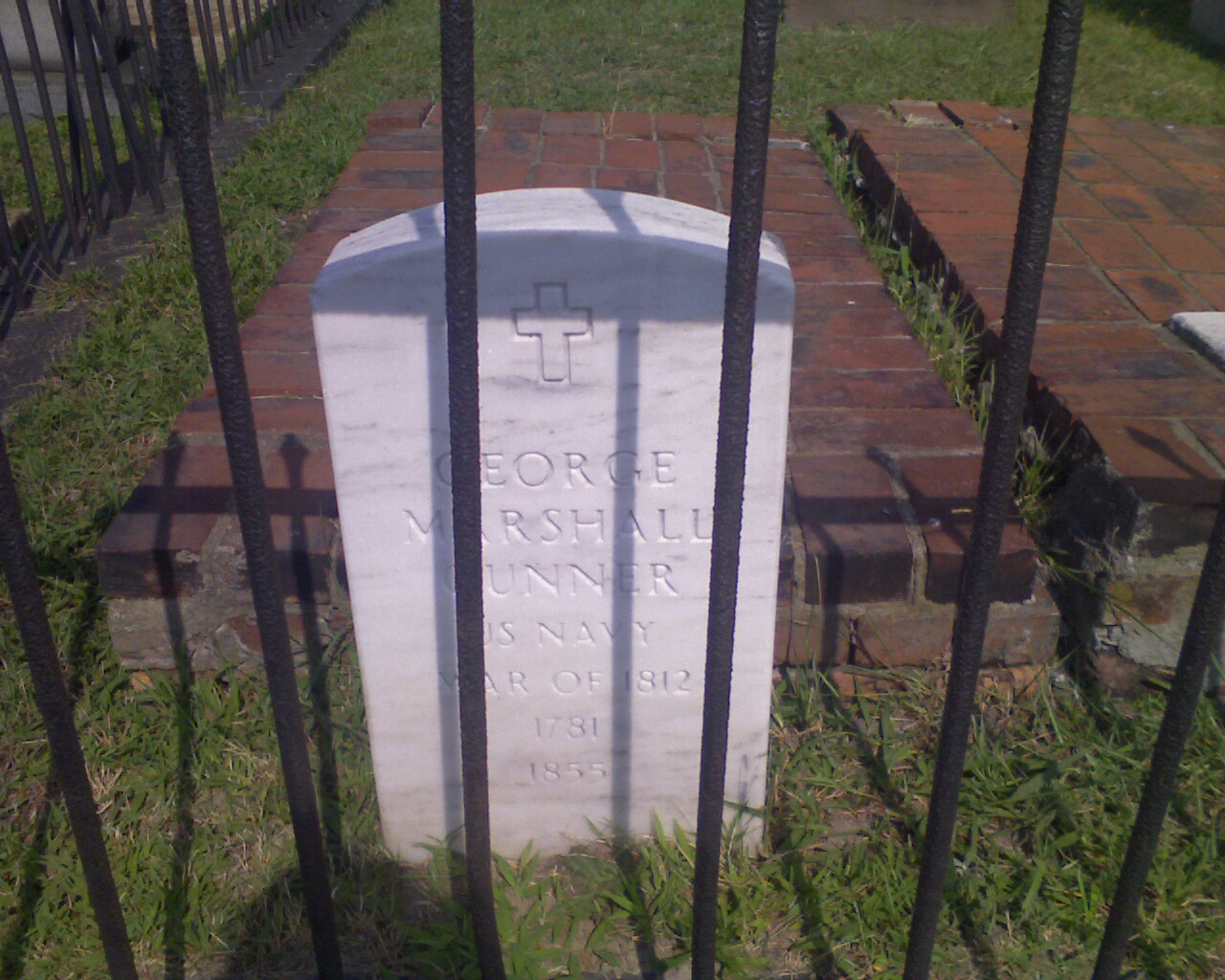George Marshall, Gunner, USN (1782-1855)
 George
Marshall was born in 1782 on the Aegean island of Rhodes in Greece. The
surname is believed to have been anglicized from the original. A
notice of his death published during the 1855 yellow fever epidemic in
Portsmouth VA included information, provided by his daughter Maria,
about his birthplace as well as these clues to the names of his
parents: "Mich." and "I."
George
Marshall was born in 1782 on the Aegean island of Rhodes in Greece. The
surname is believed to have been anglicized from the original. A
notice of his death published during the 1855 yellow fever epidemic in
Portsmouth VA included information, provided by his daughter Maria,
about his birthplace as well as these clues to the names of his
parents: "Mich." and "I."
At some time before 1806, Marshall had appeared in the United States. He received a Warrant as Gunner, USN, in 1807, and was assigned to the Washington Navy Yard (read his service record here). Around this time, he married his wife, Phillipi.
George served on several ships while maintaining a home for his young family in the Washington D.C. area. With the birth of a third surviving daughter during July 1820, the family moved with the infant and two older daughters to Portsmouth, VA. The Marshall family returned to Washington later in that decade, but ultimately came back to Portsmouth in the 1830s. The town would remain the family's home through the remainder of their lives.
Fifteen years into his service, Marshall authored Marshall's Practical Marine Gunnery: Containing a View of the Magnitude, Weight, Description & Use, of Every Article Used in the Sea Gunner's Department, in the Navy of the United States. Printed in Norfolk VA by Thomas G. Broughton "At the Office of the Norfolk and Portsmouth Herald," and published by C. Hall at the "Sign of the Ledger, Main-Street" in 1822, the Gunnery had been "strictly examined by some of the most experienced Officers in the United States' Navy" who judged the book to be "a useful work for all classes of Officers, but more particularly for the junior class." The book remained the standard practical guide for gunnery for the U.S. Navy until well after the founding of what would become the United States Naval Academy. Though obviously a document of a bygone era, traces of the Gunnery's principles still exist in U.S. Navy regulations of our own time.
 The
Gunnery's preface, given
in its entirety below, explain the scope of, and need for, a useful
technical handbook to standardize usage across the service. The
preface also alludes to Marshall's status as a non-native English speaker and
apologizes for the "harsh ... conciseness or perspicuity" of
its prose, deemed "uncouth" in comparison to the
expectation of the reading public of the time, civilian and military
alike, for the "flowers and decorations" that "constitute(d)
the beauties of style." This was a workmanlike text, not a
diversion.
The
Gunnery's preface, given
in its entirety below, explain the scope of, and need for, a useful
technical handbook to standardize usage across the service. The
preface also alludes to Marshall's status as a non-native English speaker and
apologizes for the "harsh ... conciseness or perspicuity" of
its prose, deemed "uncouth" in comparison to the
expectation of the reading public of the time, civilian and military
alike, for the "flowers and decorations" that "constitute(d)
the beauties of style." This was a workmanlike text, not a
diversion.
On 19 June 1824, Marshall was disabled while serving on USS Hornet in Gosport. In spite of being declared permanently unfit for duty, he was ordered to the USS North Carolina just months later. He served on that Mediterranean cruise in 1824-1826 as 2nd Gunner. A number of Navy men aboard that cruise, including Lt. Robert Randolph, would transfer to the U.S. Frigate Constitution in 1826, and under Randolph's sponsorship, a young Greek refugee rescued by "Old Ironsides" in May 1827 would enter the U.S. in 1828 and eventually be placed with Marshall, who treated the boy as a son, marrying him to his second daughter and teaching him the trade of gunnery. The young refugee's name was George Sirian.
Following his Mediterranean service, Marshall was again assigned to the Washington Navy Yard in 1827. Though his Navy career continued into the early 1850s and totaled more than 46 years, the North Carolina cruise was Marshall's last duty at sea.
 George
Marshall became one of the many victims of the yellow fever epidemic in
Portsmouth VA during summer 1855, and he is laid to rest near other
victims of the fever among family and friends.
George
Marshall became one of the many victims of the yellow fever epidemic in
Portsmouth VA during summer 1855, and he is laid to rest near other
victims of the fever among family and friends.
----------------------------------------
PREFACE, Marshall's Practical Marine Gunnery: Containing a View of the Magnitude, Weight, Description & Use, of Every Article Used in the Sea Gunner's Department, in the Navy of the United States.
THE following compendium of Nautical Gunnery originated in a view to individual and exclusive convenience of the Author. While performing the station he has occupied during twelve years in the United States' Navy, he had constantly to regret, the want of a circumstantial and detailed view of the duties of his department. And finding his unassisted memory inadequate to a prompt and easy command of his own experience, he saw the utility of methodizing and reducing, to established rules, the observations wherewith an active and practical life had furnished him.
The conception of his design as already state, arose entirely from motives of private convenience. Nor could the Author, indeed, at the time of its commencement, have anticipated its progress to the shape it now wears. The notes however, multiplying, with increasing years and experience, have at length assumed a form and magnitude, that in the opinion, of some of our most distinguished and scientific commanders, admit of extensive practical utility, and consequently justify publication.
But notwithstanding such assurances of success from those best qualified to judge, this little miscellany is submitted to the press, with extreme diffidence and apprehension.
The Author is an unlettered man, and even unacquainted with the grammatical parts of the English language -- Unaided therefore, by any other means of acquiring information, the following Tables and Calculations have been formed solely from actual observations, made while in the performance of professional duties -- accordingly they are destitute of every advantage of language.
But, though a refined and harmonious taste, would be disgusted at the harshness of their uncouth technicality, yet as they are only expected to give a tolerable circulation, among the Author's professional brethren, he hopes, that the conciseness
or perspicuity of terms he has been compelled to use, will compensate them for the absence of such flowers and decorations as constitute the beauties of style.
To speak now of such works as have appeared on the subject of Marine Gunnery, there are several liberal and scientific views of it, especially one published at London, in 1812, by Mr. Simmons, of the Royal Navy, a work of learning and merit ; the science and correctness of its principles, however, are unintelligible to most of our Gunners, and the plan on which it is conducted too liberal and extended to answer the practical purposes proposed from this.
Under the conviction then, that the following summary of the principles of Practical Marine Gunnery will, from its capacity of immediate application to practice, facilitate the performance of various duties and operations, now attended with labor and delay, the Author confides it to the patronage and encouragement of the OFFICERS OF THE UNITED STATES' NAVY.